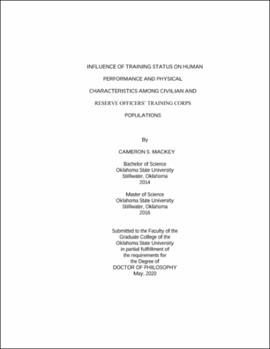| dc.contributor.advisor | DeFreitas, Jason | |
| dc.contributor.author | Mackey, Cameron S. | |
| dc.date.accessioned | 2020-09-09T21:40:43Z | |
| dc.date.available | 2020-09-09T21:40:43Z | |
| dc.date.issued | 2020-05 | |
| dc.identifier.uri | https://hdl.handle.net/11244/325531 | |
| dc.description.abstract | The primary objective of this investigation was to examine the influence of training status on human performance and physical characteristics among civilian and ROTC. Study 1 was designed to determine if maximal and rapid force characteristics as well as fatigue responses of the knee extensors and flexors could discriminate between two different types of training among men. The evidence from that investigation seems to support the idea that resistance-trained individuals may react similarly when put through a fatiguing bout of dynamic isokinetic exercise. Study 2 examined the effects of differing back squat exercises on the acute recovery responses of maximal velocity and acceleration of the knee extensors. This study revealed that both acceleration and maximal velocity may be negatively affected following exercise for up to 30-minutes post-exercise. Study 3 examined the immediate and acute recovery performance responses after performing two different back squat exercise protocols on vertical jump performance in women. The primary finding of study 3 was the immediate decrease in power, velocity, and jump height along with these variables being further decreased following the entire exercise protocol. Study 4 sought to determine if fatiguing, moderate-velocity muscle actions affect isokinetic strength characteristics to a greater extent compared to their isometric strength counterparts. The primary finding of that investigation was the significant differential acute responses between isometric and isokinetic peak torque fatigue indices. Study 5 examined ROTC cadets over a four-year period. The primary finding of that investigation was a lack of improvement in most of the variables measured during the longitudinal assessment and the absence of differences between class ranks. Study 6 was designed to determine if significant changes in cadet physical performance occur after summer break when training is not mandatory. The primary findings of this investigation were that significant reductions in performance on the fitness assessment occurred following summer break. Study 7 is designed to examine the physical fitness profile of ROTC cadets and U.S. military veterans and is currently ongoing. Preliminary results indicate cadets rank in the top 50th and veterans rank in the lower 50th percentile for most of ACSM's physical fitness evaluations. | |
| dc.format | application/pdf | |
| dc.language | en_US | |
| dc.rights | Copyright is held by the author who has granted the Oklahoma State University Library the non-exclusive right to share this material in its institutional repository. Contact Digital Library Services at lib-dls@okstate.edu or 405-744-9161 for the permission policy on the use, reproduction or distribution of this material. | |
| dc.title | Influence of training status on human performance and physical characteristics among civilian and reserve officers' training corps populations | |
| dc.contributor.committeeMember | Smith, Doug | |
| dc.contributor.committeeMember | Price, Taryn | |
| dc.contributor.committeeMember | Aichele, Doug | |
| osu.filename | Mackey_okstate_0664D_16780.pdf | |
| osu.accesstype | Open Access | |
| dc.type.genre | Dissertation | |
| dc.type.material | Text | |
| dc.subject.keywords | fatigue | |
| dc.subject.keywords | isokinetics | |
| dc.subject.keywords | military | |
| dc.subject.keywords | physical fitness | |
| dc.subject.keywords | strength | |
| dc.subject.keywords | velocity | |
| thesis.degree.discipline | Health, Leisure and Human Performance | |
| thesis.degree.grantor | Oklahoma State University | |
